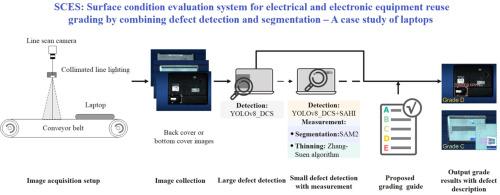基于缺陷检测和分割的电子电气设备再利用分级表面状况评估系统——以笔记本电脑为例
IF 10.9
1区 环境科学与生态学
Q1 ENGINEERING, ENVIRONMENTAL
引用次数: 0
摘要
电气和电子设备(EEE)价值回收最大化的一个重要步骤是基于表面缺陷对其进行分级以进行再利用。尽管基于计算机视觉的方法可以克服人工检测的主观性,但它们受到缺陷规模不同和小缺陷分割标注耗时的限制。本研究通过提出一种地表状况评估系统(SCES)来解决这些挑战。SCES改进了手工分级指南用于定量评估,利用缺陷通道和空间(DCS)关注模块以及切片辅助超推理(SAHI)增强了YOLOv8以改进缺陷检测,然后利用Zhang-Suen细化算法级联Segment Anything Model 2 (SAM2),在没有分割注释的情况下对小缺陷进行分割和测量。SCES对收集的笔记本电脑表面缺陷数据集的missing_battery、missing_cover和划痕的平均检测精度(AP)分别达到98.9%、81.2%和80.5%,高于其他先进方法。此外,划痕的测量精度达到85%以上,验证了所提出方法的可靠性。结果表明,该系统采用新颖的计算机视觉方法实现了产品表面状况分级的自动化和量化。本研究支持在电子电气设备再利用过程中从人工评估向高效、客观的自动化方法过渡,从而有助于资源节约。本文章由计算机程序翻译,如有差异,请以英文原文为准。

SCES: Surface condition evaluation system for electrical and electronic equipment reuse grading by combining defect detection and segmentation—A case study of laptops
An essential step to maximize value recovery in Electrical and Electronic Equipment (EEE) is grading it based on surface defects for reuse. Although state-of-the-art computer vision-based methods can overcome manual inspections’ subjectivity, they are limited by different scales of defects and time-consuming segmentation annotation of small defects. This study addresses these challenges by proposing a Surface Condition Evaluation System (SCES). SCES refines manual grading guides for quantitative evaluation, enhances YOLOv8 with proposed Defect Channel and Spatial (DCS) attention modules and Slicing Aided Hyper Inference (SAHI) to improve defect detection, then cascades Segment Anything Model 2 (SAM2) with Zhang-Suen thinning algorithm to segment and measure small defects without segmentation annotations. SCES achieves the detection average precision (AP) of 98.9 %, 81.2 %, and 80.5 % for missing_battery, missing_cover, and scratch on the collected laptop surface defect dataset, respectively, which are higher than other state-of-the-art methods. Additionally, the measurement accuracy for scratches reaches over 85 %, verifying the reliability of the proposed method. The results indicate that SCES employs novel computer vision methods to realize the automated and quantified product surface condition grading. This research supports the transition from manual evaluation to an efficient and objective automated approach in the EEE reuse process, thereby contributing to resource conservation.
求助全文
通过发布文献求助,成功后即可免费获取论文全文。
去求助
来源期刊

Resources Conservation and Recycling
环境科学-工程:环境
CiteScore
22.90
自引率
6.10%
发文量
625
审稿时长
23 days
期刊介绍:
The journal Resources, Conservation & Recycling welcomes contributions from research, which consider sustainable management and conservation of resources. The journal prioritizes understanding the transformation processes crucial for transitioning toward more sustainable production and consumption systems. It highlights technological, economic, institutional, and policy aspects related to specific resource management practices such as conservation, recycling, and resource substitution, as well as broader strategies like improving resource productivity and restructuring production and consumption patterns.
Contributions may address regional, national, or international scales and can range from individual resources or technologies to entire sectors or systems. Authors are encouraged to explore scientific and methodological issues alongside practical, environmental, and economic implications. However, manuscripts focusing solely on laboratory experiments without discussing their broader implications will not be considered for publication in the journal.
 求助内容:
求助内容: 应助结果提醒方式:
应助结果提醒方式:


